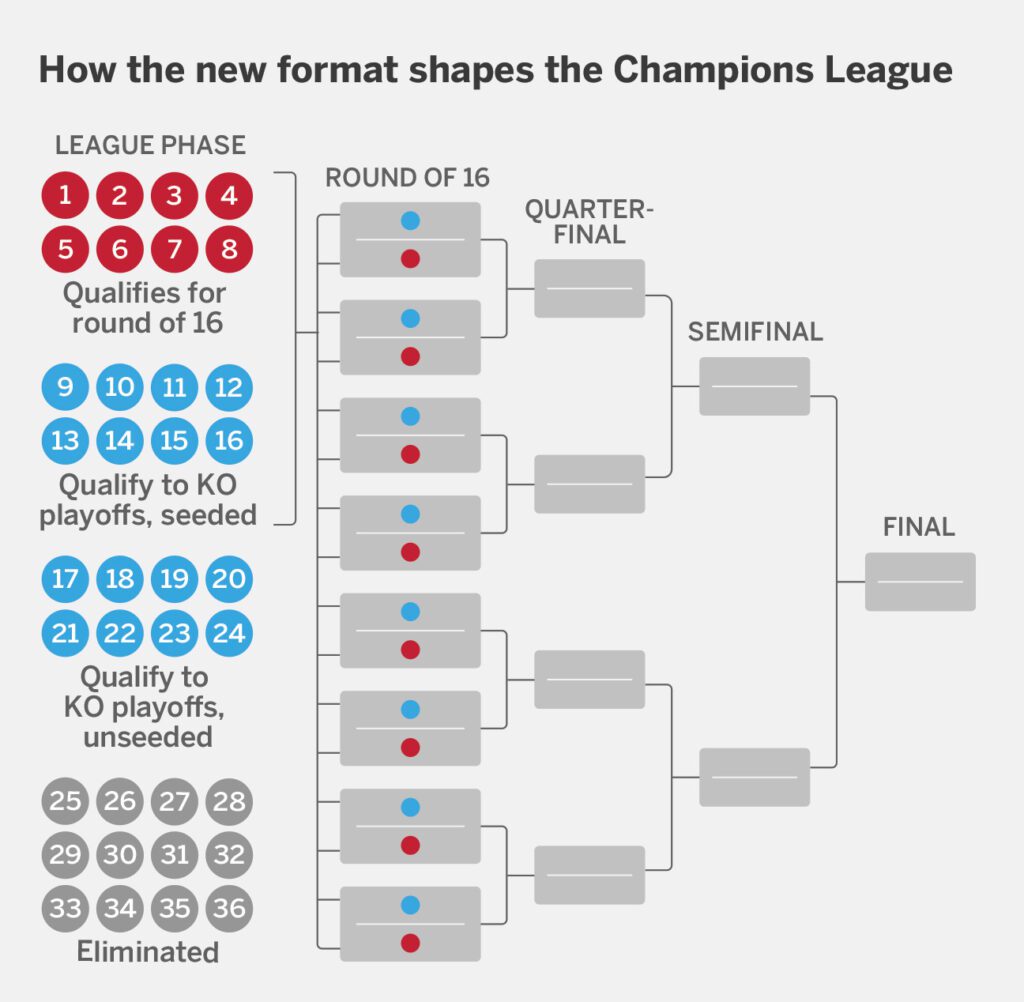After more than two decades of the same group-stage format, the UEFA Champions League is switching things up. Big time.
Starting with the 2024/25 season, Europe’s biggest club competition gets a major overhaul — more matches, more teams, more chaos (the good kind). Some of the changes are straightforward, others not so much. Here’s a breakdown of how the new format works — in plain English.
What’s Changing in the Champions League?
The biggest shift is the end of the traditional group stage. Previously, 32 teams are split into eight groups of four. But from 2024/25 onward, 36 teams will play in a single league phase, ranked together in one table.
Let’s start with the basics.
- 36 teams now qualify (up from 32)
- No more groups — it’s now called the “league phase”
- Each team plays 8 matches against 8 different opponents
- Four at home, four away
- All teams ranked in a single league table
Forget the old “Group A to H” model. This is a new era where everyone’s thrown into the same pool — and every point matters.
Quick Comparison: Old vs New Format
- Old Format: 32 teams, 6 group-stage matches, 3 opponents
- New Format: 36 teams, 8 league matches, 8 different opponents
As shown in the graph above, the new structure allows for more teams, more games, and a wider range of opponents.

How Do Teams Qualify for the Knockouts?
Here’s where it gets spicy:
- 1st–8th place: Automatically advance to the Round of 16
- 9th–24th place: Enter a playoff round to fight for a spot in the last 16
- 25th–36th place: Eliminated. No Europa League safety net. Out means out.
The playoff round is two-legged. Higher-ranked teams (9th–16th) are seeded and get the second leg at home. Winners go into the Round of 16, where the knockout stages continue as usual.
From that point on, it’s business as usual: home and away legs, no more “drop-downs” to the Europa League, and the final is still a one-off game on a neutral ground.
Where Do the 4 Extra Spots Come From?
UEFA has added four more qualification spots to the Champions League league phase:
- One goes to the third-placed team in the 5th-ranked European league.
- One goes to a domestic champion through the expanded qualification path.
- Two are awarded to the best-performing leagues from the previous season.
- How Are Fixtures Decided?
UEFA scrapped the manual draw for groups. The new system still uses four pots based on UEFA coefficients, but instead of drawing teams into groups, each club was randomly assigned two opponents from each pot. A computer handled the logistics (even Cristiano Ronaldo helped press the button).
The rules?
- You can’t face more than two clubs from the same country
- You won’t be drawn against someone from your own domestic league
- Each team plays 8 different opponents — one home, one away, per pot
It’s more complex than before — but also more balanced. For example, top clubs like Arsenal or Bayern now face a wider mix of challengers, making early matchups way more unpredictable.
What’s at Stake During the League Phase?
UEFA wants every game to matter — and they’ve set it up to make sure of that. With only 8 matches per team, the margins are razor thin.
After Matchday 7 in a recent simulation:
- Only 2 clubs were locked into the top 8
- 17 clubs were still chasing a Round of 16 spot
- 14 clubs were fighting for the last few playoff spots
- Just 3 clubs had already been eliminated
And with tiebreakers like goal difference, goals scored, and disciplinary records in play, you can bet every minute will count — especially on Matchday 8.
Champions League Calendar (New Format)
- Matches run September–January for the league phase
- Knockout playoffs begin in February
- Round of 16 kicks off in March
- Final still played in May or June, at a neutral stadium
Each UEFA competition (Champions League, Europa League, Conference League) also gets its own “exclusive week” — meaning no overlap and more spotlight.
Why This Format Could Be a Win for Fans
- More top-tier matchups early (Man City vs Bayern in September? Yes please)
- Greater variety of opponents
- No more “dead rubbers” — every point could be the difference between top 8 and going home
Plus, the updated format rewards sporting merit — qualification is still based on performance in domestic leagues and UEFA coefficients.
To find out where to watch the Champions League, click here.





